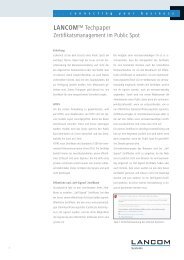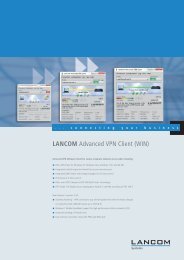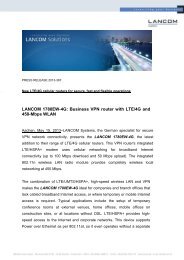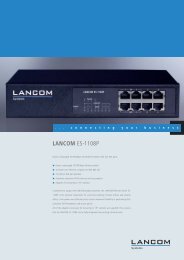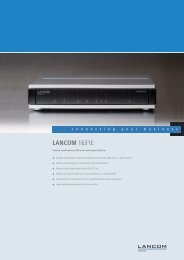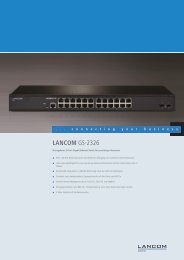LANCOM 1781VA - LANCOM Systems
LANCOM 1781VA - LANCOM Systems
LANCOM 1781VA - LANCOM Systems
Create successful ePaper yourself
Turn your PDF publications into a flip-book with our unique Google optimized e-Paper software.
<strong>LANCOM</strong> <strong>1781VA</strong> Features as of: LCOS 8.82<br />
Firewall<br />
Stateful inspection firewall<br />
Packet filter<br />
Extended port forwarding<br />
N:N IP address mapping<br />
Tagging<br />
Actions<br />
Notification<br />
Incoming/Outgoing Traffic inspection based on connection information. Trigger for firewall rules depending on backup status, e.g. simplified rule<br />
sets for low-bandwidth backup lines. Limitation of the number of sessions per remote site (ID)<br />
Check based on the header information of an IP packet (IP or MAC source/destination addresses; source/destination ports, DiffServ attribute);<br />
remote-site dependant, direction dependant, bandwidth dependant<br />
Network Address Translation (NAT) based on protocol and WAN address, i.e. to make internal webservers accessible from WAN<br />
N:N IP address mapping for translation of IP addresses or entire networks<br />
The firewall marks packets with routing tags, e.g. for policy-based routing; Source routing tags for the creation of independent firewall rules for<br />
different ARF contexts<br />
Forward, drop, reject, block sender address, close destination port, disconnect<br />
Via e-mail, SYSLOG or SNMP trap<br />
Quality of Service<br />
Traffic shaping<br />
Bandwidth reservation<br />
DiffServ/TOS<br />
Packet-size control<br />
Layer 2/Layer 3 tagging<br />
Dynamic bandwidth management with IP traffic shaping<br />
Dynamic reservation of minimum and maximum bandwidths, totally or connection based, separate settings for send and receive directions. Setting<br />
relative bandwidth limits for QoS in percent<br />
Priority queuing of packets based on DiffServ/TOS fields<br />
Automatic packet-size control by fragmentation or Path Maximum Transmission Unit (PMTU) adjustment<br />
Automatic or fixed translation of layer-2 priority information (IEEE 802.11p-marked Ethernet frames) to layer-3 DiffServ attributes in routing mode.<br />
Translation from layer 3 to layer 2 with automatic recognition of 802.11p-support in the destination device<br />
Security<br />
Intrusion Prevention<br />
IP spoofing<br />
Access control lists<br />
Denial of Service protection<br />
General<br />
URL blocker<br />
Password protection<br />
Alerts<br />
Authentication mechanisms<br />
Anti-theft<br />
Adjustable reset button<br />
Monitoring and blocking of login attempts and port scans<br />
Source IP address check on all interfaces: only IP addresses belonging to the defined IP networks are allowed<br />
Filtering of IP or MAC addresses and preset protocols for configuration access and LANCAPI<br />
Protection from fragmentation errors and SYN flooding<br />
Detailed settings for handling reassembly, PING, stealth mode and AUTH port<br />
Filtering of unwanted URLs based on DNS hitlists and wildcard filters. Extended functionality with Content Filter Option<br />
Password-protected configuration access can be set for each interface<br />
Alerts via e-mail, SNMP-Traps and SYSLOG<br />
PAP, CHAP, MS-CHAP and MS-CHAPv2 as PPP authentication mechanism<br />
Anti-theft ISDN site verification over B or D channel (self-initiated call back and blocking)<br />
Adjustable reset button for 'ignore', 'boot-only' and 'reset-or-boot'<br />
High availability / redundancy<br />
VRRP<br />
FirmSafe<br />
UMTS backup*<br />
ISDN backup*<br />
Analog/GSM modem backup<br />
Load balancing<br />
VPN redundancy<br />
Line monitoring<br />
*) Note:<br />
VRRP (Virtual Router Redundancy Protocol) for backup in case of failure of a device or remote station. Enables passive standby groups or reciprocal<br />
backup between multiple active devices including load balancing and user definable backup priorities<br />
For completely safe software upgrades thanks to two stored firmware versions, incl. test mode for firmware updates<br />
Operation of an external UMTS/HSDPA USB card at the USB host port<br />
In case of failure of the main connection, a backup connection is established over ISDN. Automatic return to the main connection<br />
Optional operation of an analog or GSM modem at the serial interface<br />
Static and dynamic load balancing over up to 4 WAN connections. Channel bundling with Multilink PPP (if supported by network operator)<br />
Backup of VPN connections across different hierarchy levels, e.g. in case of failure of a central VPN concentrator and re-routing to multiple distributed<br />
remote sites. Any number of VPN remote sites can be defined (the tunnel limit applies only to active connections). Up to 32 alternative remote<br />
stations, each with its own routing tag, can be defined per VPN connection. Automatic selection may be sequential, or dependant on the last<br />
connection, or random (VPN load balancing)<br />
Line monitoring with LCP echo monitoring, dead-peer detection and up to 4 addresses for end-to-end monitoring with ICMP polling<br />
A UMTS USB modem is not supplied. Supported UMTS USB modem at www.lancom.eu/umts-support



